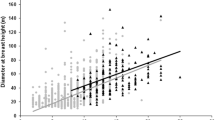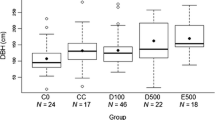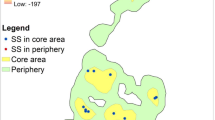Abstract
Examination of the characteristics and locations of sleeping sites helps to document the social and ecological pressures acting on animals. We investigated sleeping tree choice for four groups of Colobus vellerosus, an arboreal folivore, on 298 nights at the Boabeng-Fiema Monkey Sanctuary, Ghana using five non-mutually exclusive hypotheses: predation avoidance, access to food, range and resource defense, thermoregulation, and a null hypothesis of random selection. C. vellerosus utilized 31 tree species as sleeping sites and the species used differed per group depending on their availability. Groups used multiple sleeping sites and minimized their travel costs by selecting trees near feeding areas. The percentage that a food species was fed upon annually was correlated with the use of that species as a sleeping tree. Ninety percent of the sleeping trees were in a phenophase with colobus food items. Entire groups slept in non-food trees on only one night. These data strongly support the access to food hypothesis. Range and resource defense was also important to sleeping site choice. Groups slept in exclusively used areas of their home range more often than expected, but when other groups were spotted on the edge of the core area, focal groups approached the intruders, behaved aggressively, and slept close to them, seemingly to prevent an incursion into their core range. However, by sleeping high in the canopy, in large, emergent trees with dense foliage, positioning themselves away from the main trunk on medium-sized branches, and by showing low rates of site reuse, C. vellerosus also appeared to be avoiding predation in their sleeping site choices. Groups left their sleep sites later after cooler nights but did not show behavioral thermoregulation, such as huddling. This study suggests that access to food, range and resource defense, and predation avoidance were more important considerations in sleeping site selection than thermoregulation for ursine colobus.


Similar content being viewed by others
References
Altmann J (1974) Observational study of behaviour: sampling methods. Behaviour 49:227–267
Anderson JR (1984) Ethology and ecology of sleep in monkeys and apes. Adv Stud Behav 14:165–229
Anderson JR (1998) Sleep, sleeping sites, and sleep-related activities: awakening to their significance. Am J Primatol 46:63–75
Anderson JR (2000) Sleep-related behavioural adaptations in free-ranging anthropoid primates. Sleep Med Rev 4:355–373
Anderson JR, McGrew WC (1984) Guinea baboons (Papio papio) at a sleeping site. Am J Primatol 6:1–14
Andersson M (1978) Optimal foraging area: size and allocation of search effort. Theor Pop Biol 13:397–409
Andersson M (1981) Central place foraging in the whinchat Saxicola rubetra. Ecology 62:538–544
Aquino R, Encarnación F (1986) Characteristics and use of sleeping sites in Aotus (Cebidae: Primates) in the Amazon of Peru. Am J Primatol 18:319–331
Bert J, Ayats H, Martino A, Collomb H (1967) Le sommeil nocturne chez le babouin Papio papio: observations en milieu naturel et donnees electrophysiques. Folia Primatol 6:28–43
Bodendorfer T, Hoppe-Dominik B, Fischer F, Linsenmair KE (2006) Prey of the leopard (Panthera pardus) and the lion (Panthera leo) in Comoé and Marahoué National Parks, Côte d’Ivoire, West Africa. Mammalia 2006:231–246
Chapman CA (1989) Spider monkey sleeping sites: use and availability. Am J Primatol 18:53–60
Chapman CA, Chapman LJ, McLaughlin RL (1989) Multiple central place foraging by spider monkeys: travel consequences of using many sleeping sites. Oecologia 79:506–511
Chivers DJ (1974) The siamang in Malaya. Karger, Basel
Cosmides L, Tooby J (2000) Evolutionary psychology and the emotions. In: Lewis M, Haviland-Jones JM (eds) Handbook of emotions, 2nd edn. Guilford, New York, pp 91–115
Cui L-W, Quan R-C, Xiao W (2006) Sleeping sites of black-and-white snub-nosed monkeys (Rhinopithecus bieti) at Baima Snow Mountain, China. J Zool 270:192–198
Dasilva GL (1992) The western black-and-white colobus as a low-energy strategist: activity budgets, energy expenditure and energy intake. J Anim Ecol 61:79–91
Dasliva GL (1993) Postural changes and behavioural thermoregulation in Colobus polykomos: the effect of climate and diet. Afr J Ecol 31:226–241
Dawson GA (1979) The use of time and space by the Panamanian tamarin Saguinus oedipus. Folia Primatol 31:253–284
Day RT, Elwood RW (1999) Sleeping site selection by the golden-handed tamarin Saguinus midas midas: the role of predation risk, proximity to feeding sites, and territorial defence. Ethology 105:1035–1051
Di Bitetti MS, Vidal EML, Baldovino MC, Benesovsky V (2000) Sleeping site preferences in tufted capuchin monkeys (Cebus apella nigritus). Am J Primatol 50:257–274
Fan P, Jiang X (2008) Sleeping sites, sleeping trees, and sleep-related behaviors of black-crested gibbons (Nomascus concolor jingdongensis) at Mt. Wuliang, Central Yunnan, China. Am J Primatol 70:153–160
Fan PF, Jlang XL (2008) Sleeping sites, sleeping trees, and sleeping-related behaviours of black crested gibbons (Nomascus concolor jingdongensis) at Mt. Wuliang, Central Yunnan, China. Am J Primatol 70:153–160
Fargey PJ (1991) Assessment of the conservation status of the Boabeng-Fiema Monkey Sanctuary. Final report to the Flora and Fauna Preservation Society. University of Science and Technology, Kumasi
Gautier-Hion A (1970) L’organisation sociale d’une bande de talapoins (Miopithecus talapoin) dans le nord-est du Gabon. Folia Primatol 12:116–141
Hamilton WJ (1982) Baboon sleeping site preference and relationship to primates grouping patterns. Am J Primatol 3:41–53
Hausfater G, Meade BJ (1982) Alternation of sleeping groves by yellow baboons (Papio cynocephalus) as a strategy for parasite avoidance. Primates 23:287–297
Hawthorne WD (1990) Field guide to the forest trees of Ghana. Natural Resources Institute, Chatham
Heymann EW (1995) Sleeping habits of tamarins, Saguinus mystax and Saguinus fuscicollis (Mammalia; Primates; Callitrichidae), in north-eastern Peru. J Zool 237:211–226
Holmes TD, Bergstrom ML, Fedigan LM (2011) Sleeping site selection by white-faced capuchins (Cebus capucinus) in the Area de Conservación Guanacaste, Costa Rica. Ecol Environ Anthropol 6:1–9
Kankam BO, Saj TL, Sicotte P (2010) How to measure “success” in community-based conservation projects: the case of the Boabeng-Fiema Monkey Sanctuary in Ghana. In: Puplampu KP, Tettey WJ (eds) The public sphere and the politics of survival in Ghana. Woeli, Accra, pp 115–141
Kryn JM, Fobe EW (1959) The woods of Liberia. US Department of Agriculture Forest Service, Madison
Li D, Ren B, Grueter CC, Li B, Li M (2010) Nocturnal sleeping habits of the Yunnan snub-nosed monkey in Xiangguging, China. Am J Primatol 72:1092–1099
Liu Z, Zhao Q (2004) Sleeping sites of Rhinopithecus bieti at Mt. Fuhe, Yunnan. Primates 45:241–248
Matsuda I, Tuuga A, Higashi S (2010) Effects of water level on sleeping-site selection and inter-group association in proboscis monkeys: why do they sleep alone inland on flooded days? Ecol Res 25:475–482
McLaughlin RL, Montgomerie RD (1989) Brood dispersal and multiple central place foraging by Lapland longspur parents. Behav Ecol Sociobiol 25:206–207
Mendes Pontes AR, Soares ML (2005) Sleeping sites of common marmosets (Callithrix jacchus) in defaunated urban forest fragments: a strategy to maximize food intake. J Zool Lond 266:55–63
Orians GH, Pearson NE (1979) On the theory of central place foraging. In: Horn DJ, Mitchell RD, Stairs GR (eds) Analysis of ecological systems. Ohio University Press, Ohio, pp 155–177
Phoonjampa R, Koenig A, Borries C, Gale GA, Savini T (2011) Selection of sleeping trees in pileated gibbons (Hylobates pileatus). Am J Primatol 72:617–625
Ramirez MM (1989) Ecology and demography of the moustached tamarin, Sanguinus mystax in north eastern Peru (Ph.D. Thesis). City University, New York
Reichard U (1998) Sleeping sites, sleeping places, and presleep behavior of gibbons (Hylobates lar). Am J Primatol 46:35–62
Saj TL, Sicotte P (2005) Male takeover in Colobus vellerosus at Boabeng-Fiema Monkey Sanctuary, central Ghana. Primates 46:211–214
Saj TL, Teichroeb JA, Sicotte P (2005) The population status of the ursine colobus (Colobus vellerosus) at Boabeng-Fiema, Ghana. In: Paterson JD, Wallis J (eds) Commensalism and conflict: the human–primate interface. American Society of Primatologists, Norman, pp 350–375
Savage A (1990) The reproductive biology of the cotton-top tamarin (Saguinus oedipus oedipus) in Columbia (Ph.D. dissertation). University of Wisconsin, Madison
Schoener TW (1979) Generality of the size–distance relation in models of optimal feeding. Am Nat 111:902–914
Schubert R (2011) The conservative nature of primate positional behavior: testing for locomotor and postural variation in Colobus vellerosus and Cercopithecus campbelli lowei at Boabeng-Fiema Monkey Sanctuary, Ghana (Ph.D. dissertation). The Ohio State University, Columbus
Sicotte P, MacIntosh AJ (2004) Inter-group encounters and male incursions in Colobus vellerosus in central Ghana. Behaviour 141:533–553
Sigg H, Stolba A (1981) Home range and daily march in a Hamadryas baboon troop. Folia Primatol 36:40–75
Smith AC, Knogge C, Huck M, Lottker P, Buchanan-Smith HM, Heymann EW (2007) Long-term patterns of sleeping site use in wild saddleback (Saguinus fuscicollis) and mustached tamarins (S. mystax): effects of foraging, thermoregulation, predation, and resource defense constraints. Am J Phys Anthropol 134:340–353
Sugardjito J (1983) Selecting nest-sites of Sumatran orang-utans, Pongo pygmaeus abelii in the Gunung Leuser National Park, Indonesia. Primates 24:467–474
Sun C, Kaplin BA, Kristensen KA (1996) Tree phenology in a tropical montane forest in Rwanda. Biotropica 28:661–668
Teichroeb JA, Sicotte P (2008a) Infanticide in ursine colobus monkeys (Colobus vellerosus): new cases and a test of the existing hypotheses. Behaviour 145:727–755
Teichroeb JA, Sicotte P (2008b) Social correlates of fecal testosterone in male ursine colobus monkeys (Colobus vellerosus): the effect of male reproductive competition in aseasonal breeders. Horm Behav 54:417–423
Teichroeb JA, Wikberg EC, Sicotte P (2011) Dispersal in male ursine colobus monkeys (Colobus vellerosus): influence of age, rank, and contact with other groups on dispersal decisions. Behaviour 148:765–793
Teichroeb JA, Sicotte P (2012) Cost-free vigilance during feeding in folivorous primates? Examining the effect of predation risk, scramble competition, and food handling on vigilance in ursine colobus monkeys (Colobus vellerosus). Behav Ecol Sociobiol. doi:10.1007/s00265-011-1292-1
Teichroeb JA, Saj TL, Paterson JD, Sicotte P (2003) Effect of group size on activity budgets in ursine colobus (Colobus vellerosus) in Ghana. Int J Primatol 24:743–758
Tenaza R, Tilson RL (1985) Human predation and Kloss’s gibbons (Hylobates klossii) sleeping trees in Siberut Island, Indonesia. Am J Primatol 8:299–308
Von Hippel FA (1998) Use of sleeping trees by black and white colobus monkeys (Colobus guereza) in the Kakamega Forest, Kenya. Am J Primatol 45:281–290
Wong SNP, Sicotte P (2006) Population size and density of Colobus vellerosus at the Boabeng-Fiema Monkey Sanctuary and surrounding forest fragments in Ghana. Am J Primatol 68:465–476
Wrangham RW, Carmody R (2010) Human adaptation to the control of fire. Evol Anthropol 19:187–199
Zhang S (1995) Sleeping habits of brown capuchin monkeys (Cebus apella) in French Guiana. Am J Primatol 36:327–335
Acknowledgments
We thank the Ghana Wildlife Division and the management committee of the Boabeng-Fiema Monkey Sanctuary for permission to conduct this research. NSERC, the University of Calgary, and the Province of Alberta provided funding. Anthony Dassah, Robert Koranteng, Kwame Duodo, Kwaku Amponsah, and Rachel Boratto provided research assistance. This research complied with the laws of Ghana and was approved by the University of Calgary’s Animal Care Committee. This manuscript was improved with the helpful comments provided by Dr. Colin Chapman, Dr. Rafael Reyna-Hurtado, and one anonymous reviewer.
Author information
Authors and Affiliations
Corresponding author
About this article
Cite this article
Teichroeb, J.A., Holmes, T.D. & Sicotte, P. Use of sleeping trees by ursine colobus monkeys (Colobus vellerosus) demonstrates the importance of nearby food. Primates 53, 287–296 (2012). https://doi.org/10.1007/s10329-012-0299-1
Received:
Accepted:
Published:
Issue Date:
DOI: https://doi.org/10.1007/s10329-012-0299-1




